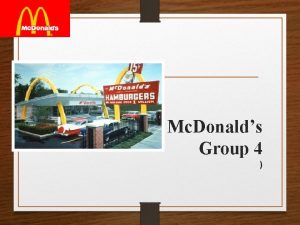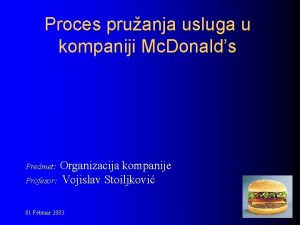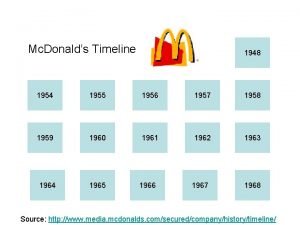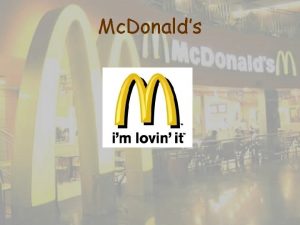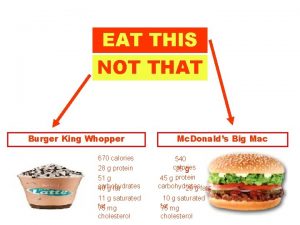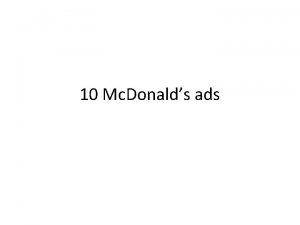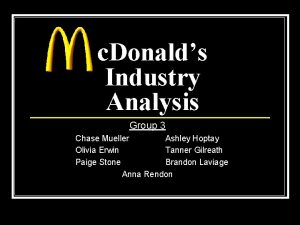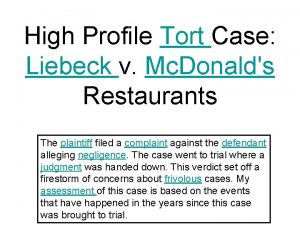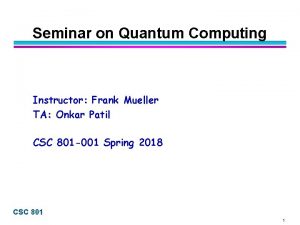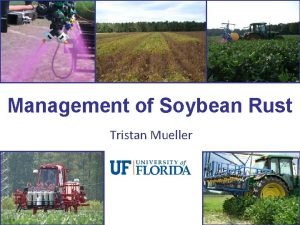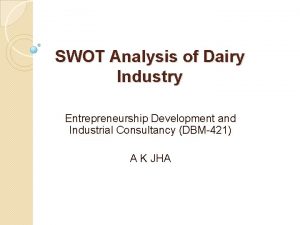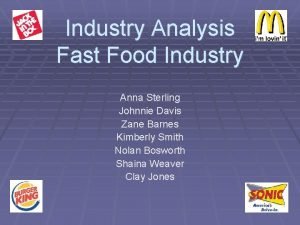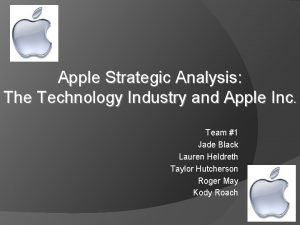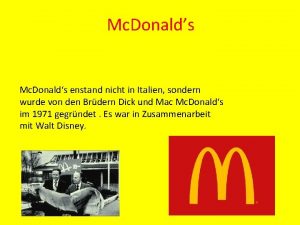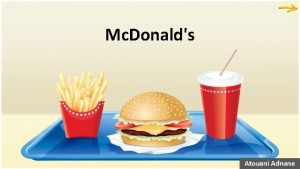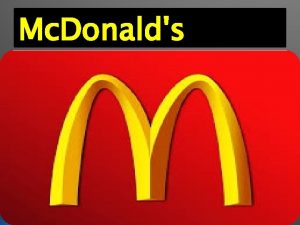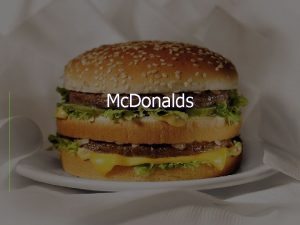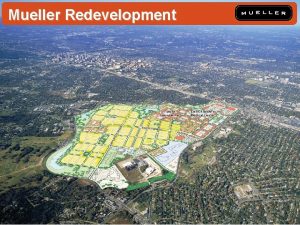c Donalds Industry Analysis Group 3 Chase Mueller





























































- Slides: 61

c. Donald’s Industry Analysis Group 3 Chase Mueller Ashley Hoptay Olivia Erwin Tanner Gilreath Paige Stone Brandon Laviage Anna Rendon

SIC Codes n The fast food industry is categorized under: n SIC 5812, Eating Places n n establishments primarily engaged in the retail sale of prepared food and drinks for on-premise or immediate consumption as well as caterers and industrial and institutional food service establishments. Consists of seven different categories: dinner theaters, fullservice restaurants, limited-service restaurants, cafeterias, snacks and nonalcoholic beverage bars, food service contractors, and caterers.

NAICS Codes n With the replacement of the SIC Codes, the fast food industry is categorized under: n NAICS 722211, Limited-Service Restaurants n n establishments primarily engaged in (1) providing food services where patrons generally order or select items and pay before eating or (2) selling a specialty snack or nonalcoholic beverage for consumption on or near the premises. Orders may be consumed on premises, carried out, or delivered to the customers’ location such as pizza delivery.

History of Fast Food Industry n 1921 – White Castle is viewed as the beginning of fast food n n Changed the public’s perception; gave hamburgers a better reputation of quality and gave the image of cleanliness through its use of “white” Rise of cars also gave rise to the industry n Many restaurants utilized short-hand cooks, drive-ins, and carhops to capitalize on the new craze that the American people had with staying in the car and eating.

History of Fast Food Industry n n 1948 – Dick and Mac Mc. Donald reopen their restaurant, Mc. Donald’s Famous Hamburgers, after implementing the “Speedee Service System”, which is synonymous with the assembly line. Simplified operations. The Mc. Donald brothers also switched from dishes and glassware to paper and plastic to increase efficiency.

History of Fast Food Industry Ray Kroc capitalized on the blue ocean that the Mc. Donald’s brothers created n 1955 – Ray Kroc opened the first restaurant in the Mc. Donald’s Corporation n As other fast food restaurants opened in the mid-1950 s to the late-1960 s, they imitated and implemented the “Speedee Service System”. n

The Four Major Players n Mc. Donald’s is the leading global quick service restaurant retailer as well as one of the world’s most well-known and valuable brands. n n n 31, 377 restaurants in 118 countries Franchisees operate 20, 505 restaurants YUM! Brands Incorporated consists of KFC, Pizza Hut, Taco Bell, Long John Silvers, and A&W All-American Food Restaurants. n 35, 000 restaurants in 100 countries and territories n 80% owned by independent franchise operators.

The Four Major Players n Burger King Holdings, Incorporated n n n Operates 11, 565 restaurants in the United States, Canada, Europe, the Middle East, Africa, the Asia Pacific, and Latin America. 10, 205 are owned by franchisees. Wendy’s/Arby’s Group n n Operates about 10, 000 restaurants in the United States and 21 countries. 6, 645 of them are Wendy’s, and 5, 231 of all Wendy’s fast food restaurants are franchised.

The Four Major Players n Hedgehog Concept n n The fast food industry utilizes the hedgehog concept of doing one thing really well: to serve the most customers as possible in a given time period. The four companies focus on speed, quality, and convenience, and they keep these factors at the forefront of their operations in every location.

The Four Major Players n Hedgehog Concept n n n One of the key success factors of the fast food industry is uniformity, which has allowed the companies to go global and exceed at their endeavors. Offering the same service at every location gives customers reassurance in the brand Ray Kroc was quoted as saying, “the organization cannot trust the individual; the individual must trust the organization. ”

Chief Business and Economic Characteristics Fast food restaurants represent one of the largest segments of the food industry. n In the United States alone, over 200, 000 fast food restaurants are operated bringing in $120 billion a year. n Also known as quick service restaurants. n

Chief Business and Economic Characteristics n n Industry is made up of international, regional and local chains Chains can be corporate owned or franchised

Chief Business and Economic Characteristics n Franchising: n n The fast food industry can contribute much of its growth and success to franchising Why franchise? n n Franchisees are given the ability to leverage a well-known brand name and benefit from the purchasing efficiencies and operational expertise of the franchiser. Franchisers still hold the right to control operational guidelines and quality adherence, and they also hold most of the rights over menu offerings, hours of operation, pricing, and store design. Gives the company the ability to grow.

Chief Business and Economic Characteristics n Franchising and Mc. Donald’s: n n Kroc realized the company could be franchised differently than others, which would help them grow and attain profits. Mc. Donald’s invested in real estate and rented the property to its franchisees, which enabled the returns to be much higher. Largest owner of retail property in the world Makes most of its profits from rent it receives from its franchisees

Chief Business and Economic Characteristics n Convenience n n Volume-driven business so customer convenience is key Located in high traffic areas Transaction speed is vital to ensure more customers are served in a given amount of time Limited menus speed the food preparation process and help with quality control by reducing the amount of worker error

Chief Business and Economic Characteristics n Technology n Used to maximize efficiency and effectiveness n n Double drive-thru windows – speed transaction time Inventory management/automated replenishment – important since dealing with perishable items; saves time dealing with suppliers, new equipment, and computerization New equipment - ovens that combine convection heat, air impingement, and microwave energy to help cook the food faster Computerization – Point-of-Sale (POS) Systems and Express pay; reduce ordering errors and cut down transaction time

Chief Business and Economic Characteristics n Technology and Mc. Donald’s n Mc. Donald’s has been at the forefront of fast food technology since the company opened n n n Implemented E-ZPass, Fas. Trak, and Freedom. Pay on top of Express Pay Mc. Donald’s Philippines Help Desk Service Echelon’s Lon. Works Technology

Chief Business and Economic Characteristics n Role of Government n The government does not control profits or contracts of the industry, but local, state, and federal governments have adopted laws and regulations that involve various aspects of the restaurant business, such as: • Advertising • Environment • Franchising • Zoning • Health • Employment • Safety n Legal and regulatory environment of the industry worldwide exposes the companies to complex compliance, litigation, and other risks that affect operations and increase the cost of doing business Developing markets also bring risks associated with new and untested laws and judicial systems n

Chief Business and Economic Characteristics n Role of Government: Intellectual Property n n n Each company owns or is licensed to use trademarks, service marks, patents, copyrights, trade secrets, and other proprietary information that is important to the company’s business. Depending on the jurisdiction, trademarks and service marks are generally valid as long as they are being used or are registered. However, patents, copyrights, and licenses only last for various durations.

Chief Business and Economic Characteristics n Role of Government and Mc. Donald’s n n n The “Mc. Donald’s” trademark and the “Golden Arches” logo are imperative to the company’s business and brand equity. The “Golden Arches” are now more widely recognized than the Christian cross To protect its investments in foreign operations, Mc. Donald’s uses forward foreign exchange contracts, foreign currency exchange agreements, and foreign currency denominated debt

Chief Business and Economic Characteristics n Problems and Issues n The fast food industry has taken a lot of heat for: n n Advertising to children – it sparks obesity at a young age Health concerns – taking the blame for people’s diet issues and weight related diseases Environment – no federal laws or regulations; must follow local laws; largest consumer of electricity in the American retail sector; accounts for 20% of U. S. litter Employment concerns – largest private sector employer; do not offer workers valuable life experience, the opportunity to move up, safe working conditions, or satisfactory wages and benefits

Chief Business and Economic Characteristics n Mass Production and Control of Suppliers n n n Mass production is utilized to retain consistency and uniformity in products Food is mass produced in a factory Since this process involves sending a large amount of food through a factory in a short amount of time, bacteria, viruses, and parasites can contaminate a significant portion of the food very easily and quickly

Chief Business and Economic Characteristics n Mass Production and Control of Suppliers n n n A handful of corporations have an unprecedented degree of power over the nation’s food supply. The vast purchasing power and demand for a uniform product have encouraged fundamental changes in how cattle are raised, slaughtered, and processed, which has made the meatpacking industry very dangerous for both its employees and consumers of the product. Can induce deadly pathogens such as E. coli.

Chief Business and Economic Characteristics n Mass Production, Control of Suppliers and Mc. Donald’s n n Safety control through Echelon’s Lon. Works Technology Taken stands against the meatpacking industry by only purchasing the meat that followed FDA rules

Chief Business and Economic Characteristics n Competitive Environment n All companies compete on the basis of quality of food and quick service; therefore, differentiation is key n n High levels of competition have caused bloody red oceans in this industry n n Service, experience and brand name Dollar menus and value meals Chains own about 88% of the market share causing independents to go out of business much faster than the national failure rate; rising threat of fast casual restaurants is currently low

Chief Business and Economic Characteristics n Economic Factors: State of the economy n n The spending slowdown and high food and energy prices have caused a slowdown in growth in the fast food industry In 2008, 55% of restaurant operators reported a same-store sales decline Food and beverage inputs account for 33 cents for every dollar of sales. With already low operating margins, a slight increase in these costs can have an outsized effect on profitability. The bloody red oceans caused by price wars makes it difficult to pass the rising costs to customers

Chief Business and Economic Characteristics n Economic Factors: State of the economy n n n Explosive growth in foreign markets offset slowing growth in the United States Prices are being cut in China, which is Mc. Donald’s and YUM! Brands largest market for growth However, the limited-service eating places are in better shape than the full-service eating places. n With the economic downturn, more people are cutting back on how much they spend when eating out, and therefore, are turning to fast food restaurants.

Chief Business and Economic Characteristics n Economic Factors: Market Growth n n n Gaining new customers as consumers are looking for the convenience of eating out and quality meals at lower prices Due to China’s size and growth rate, it still remains an attractive market Vast room for international growth as well as exploring strategy canvases enables the industry to grow and remain attractive n Mc. Donald’s utilizes research and development to cater to international tastes and attain customers

Chief Business and Economic Characteristics n Strategy Canvases and Mc. Donald’s n n n Mc. Cafes – increase customer base and redefine Mc. Donald’s image Revamping stores in the United Kingdom to appeal to businessmen/women and increase the experience of all customers Constantly searching for ways to redefine its market boundaries or to create blue oceans and attain a larger market share as well as provide its customers with more convenience and a better experience.

Social Factors n Health Food n n n New menu items Listing nutritional facts Corporate Social Responsibility n n Ronald Mc. Donald House Dave Thomas Foundation

Social Factors n Diversity n n n Workers Pride 360˚ “Going Green” n n Packaging Buildings

Technological Trends n Wi-Fi n n n Equipment n n n 15, 000 Mc. Donald’s Burger King, Wendy’s, Subway, Taco Bell Drive – Thru’s Outsourcing orders Time Clocks

Economic Factors n Current Economic Status n n People want cheap food Minimum Wage n n High percent of workers make minimum wage Raise food prices

Political and Legal n “Cheeseburger Bill” n n State Issues n n California - ban on fast food International Issues n n Prevent law suits Canada - calorie count Law Suits

Geographical Factors n Globalization n Convenient locations n n n Mc. Donalds - 60% Yum! Brands - 50% Way home from work Corner of block Malls, Supermarkets, Gas Stations n n Mc. Donalds - Wal-Mart Little Caesars - K-Mart

Competitive Factors n All other factors n n n Social Technological Economic Political/Legal Geographical Predicting next move

5 Forces Model n Rivalry Among Existing Firms n Main Competitors n n Mc. Donald's, Yum! Brands, Wendy’s, Burger King Total Industry Sales Growth 9. 85% Industry Growth 6. 02% 8. 42% 2. 16% 2005 2006 2007 Year 2008

5 Forces Model n Concentration of Competitors 58. 36% 59. 09% Market Share 59. 82% Percentage 59. 80% Burger King 28. 53% 7. 46% 27. 93% 7. 54% 2004 Yum Brands 27. 33% 7. 18% 5. 44% 5. 65% Wendy's 5. 67% 2005 Mc. Donalds 27. 36% Year 27. 49% 6. 47% 6. 98% 5. 90% 5. 86% 2006 60. 14% 2007 2008

5 Forces Model n Differentiation n n Hard to separate each other because they offer similar products So they compete on price § Mc. Donald’s able to dominate the market because of the size of the company n Switching Costs n Hard to do, why? § Real Estate, franchisees, and many employees

5 Forces Model n Economies of Scale n Efficiency § R&D, New Technology n Economies of Scope n Learning from past experiences § Example: Dollar Menu

5 Forces Model n Threat of New Entrants n Economies of Scale $29, 989 $27, 838 Total Assets $25, 525 Mc. Donald's $5, 620 $2, 458 $1, 848 2004 Yum Brands $5, 696 Burger King $5, 698 $2, 665 $1, 846 2005 $28, 975 $29, 392 Wendy's $6, 368 $2, 552 $2, 060 $2, 723 $2, 072 2006 Year 2007 $7, 242 $2, 517 $1, 789 2008

5 Force Model n First Mover Advantage n n Get in while its early, and grasp suppliers and consumers Legal Barriers n Patents, trademarks, contracts, licenses, and government regulations to limit new companies

5 Forces Model n Threat of Substitute Products n Relative Price and Performance n n Everyone produces the same products, need to compete on price and convenience Buyers Willingness to Switch n Brand performance, and high quality relationships with customers

5 Forces Model n Bargaining Power of Buyers n Price Sensitivity n n Differentiation of products, and cost of switching to another firm, easy in the fast food industry Relative Bargaining Power n n Real vs. Nominal buying power Customer Loyalty

5 Forces Model n Bargaining Power of Suppliers n Price Sensitivity n n Leverage over small suppliers Large Industry, companies name prices and quantities Supplier relations and price breaks Strategic Alliances

Competitive Moves n Mc. Donalds n n is the industry leader and has been known as the industry trend setter, yet it has not always been at the forefront on capitalizing new niche markets They were the first to create and master the “speedee service system “ also known as the assembly line They were also made the first strategic move of purchasing their own land to rent to franchisees They were also the first to advertise with an character , which strengthened their brand equity

Competitive Moves n YUM! Brands n Taco Bell n n n The first fast food chain to offer free drink refills for its customers Also created a 3 tier pricing strategy, offering products at 79¢, 89¢, 99¢ Also the first its menu completely trans-fat free

Competitive Moves n KFC n n n Was the first company to franchisee its businesses Made the strategic move of offering home cooked style meals, which included coleslaw, macaroni and cheese, baked beans, and rice Burger King n Was the first to emphasize customized order with its “Have It Your Way “ campaign

Competitive Moves n Wendy’s n n n First to implement value menu, also referred to as the dollar menu First to create a super bar which was their concept of an all you can eat buffet First to introduce salads and grilled chicken sandwiches

Next Competitive Moves n n n Mc. Donalds is seen as being the company who will make the next strategic moves because of their need to be at the forefront of the market and remain the leader in the industry. Implementation of the Mc. Cafes to draw customers from coffee shops First to respond to economic downturn by lowering prices

Competitive Success n Customers seek products that are readily available and quickly delivered n Major fast food players look across the industry to understand the driving forces behind the market’s competitive success, so companies can capitalize on these concepts

Industry’s Consistency Approach n n n One of the biggest key success factors for the fast food industry is their ability to offer consistent products and services at every location Franchises and chain stores must reliably offer the same product or service at numerous locations to build customer loyalty YUM! Brands, Wendy’s, and Burger King all take the same approach which has made them leading competitors with Mc. Donald’s

Icons n n n Another driving force of the fast food industry has been its ability to capture both young and old audiences Each leading competitor has easily recognizable icons that appeal to its target audience, which in turn differentiates them from its competitor These icons are easily recognizable and add to the experience when eating and also create a positive attitude

Convenience n n n Consumers look to quick services restaurants to provide them with a quality meal that will fit into the pace of their fast moving lifestyles The large number of locations within close proximity to each other is ensure customer convenience at every turn Many fast food chains can be spotted at shopping centers, airports, gas stations

Franchising the Industry n Franchising has played a key role in the success and growth of the fast food industry

Inside Out Approach: Focusing on Quality n Mc. Donalds has taken an “inside out” approach to drive sales, by improving its inside approaches of store operations, product offerings, and customer experiences

Mc. Donald’s Skillful Marketing: 5 P’s n People n n Products n n In order to ensure a friendlier and more customer focused support staff the emphasize hospitality training known as the People Approach Respect, Commitment Enhancement, & Talent Management Incorporates uniform quality products and implemented the Mc. Donald’s Holistic Approach- High Quality Choices, Consumer Friendly Nutrition Information, & Communicate Responsibly Place n Each location is strategically analyzed based on demographics, population, major roadways, and traffic that passes through the site to find the best location

Mc. Donald’s Skillful Marketing: 5 P’s n Price n n Allows customers to enjoy a quality meal without a hefty price Created the Value Menu (Dollar Menu) to get great food at bargain prices Although Mc. Donald’s is taking dollar menu items as a “loss leader” adding to the menu such as large fries and a drink has allowed the restaurant to be profitable Promotion n n Promotional character and symbols Subliminal Marketing Co-operative Marketing Traditional Advertising

Conclusion n After analyzing the fast food industry’s history, growth, and current success factors, one can conclude that it is safe to stay in this particular industry. The fast food industry has seen substantial growth since its creation through the proliferation of its chains through franchises. By franchising the industry, chains have been able to rapidly expand quickly capture a large percentage of the market share at a cheaper cost to them. The major players in the fast food industry offer consistency and convenience, which are two characteristics of commodities that people search for because these needs have been instilled in people since they were born.

Conclusion n Some may argue that the industry is coming to a halt due to the market saturation in the United States, but there is a lot of room for growth nationally and internationally. The industry also does not need to worry about new threats entering the market at this time because of the state of the economy. Mc. Donald’s understands the importance of brand awareness and recognition, so it consistently spends the most on advertising, which has solidified its position as one of the most well known brands in the world.

Conclusion n Mc. Donald’s stands at the forefront of the fast food industry. Another driving force that keeps the company locked in its position is the large amount of capital that Mc. Donald’s owns as well as its influence with other industries. Mc. Donald’s is the largest private real estate owner, and the company employs about 1. 6 million people worldwide, plus it is a large purchaser of beef, poultry, pork, cheese, beverages, and paper and packaging material. Therefore, the company is extremely vital to the industry as well as the economy as a whole because its presence impacts jobs and the success of other industries. This also reinforces the company’s and the industry’s market strength and attractiveness.
 Competitive profile matrix mcdonalds
Competitive profile matrix mcdonalds Mc donalds nis
Mc donalds nis Slogan i'm lovin it
Slogan i'm lovin it Starbucks mission and vision
Starbucks mission and vision Mc donalds 1955
Mc donalds 1955 Diplodocus diagram
Diplodocus diagram Dene donalds
Dene donalds Mc chain food
Mc chain food Mc donalds mc flurry calories
Mc donalds mc flurry calories Eid mubarak mcdonald's ad
Eid mubarak mcdonald's ad C.donalds
C.donalds Amy mc donald
Amy mc donald Mc donalds gutscheone
Mc donalds gutscheone Mc donalds
Mc donalds Dmc donalds
Dmc donalds Torts case
Torts case Unternehmensleitbild mc donalds
Unternehmensleitbild mc donalds Forme poslovnog pisma
Forme poslovnog pisma Geburtstag 46 jahre frau
Geburtstag 46 jahre frau Martin seligman kerry mueller
Martin seligman kerry mueller Frances mueller
Frances mueller Mueller hillis maneuver
Mueller hillis maneuver Frank mueller ncsu
Frank mueller ncsu Erich mueller cornell
Erich mueller cornell Mueller park jr high
Mueller park jr high Selective media
Selective media Time remnant
Time remnant Müller
Müller David huse
David huse Nikki seligman
Nikki seligman Moritz mueller swinburne
Moritz mueller swinburne Carolina henriquez
Carolina henriquez Pat mueller
Pat mueller Omegascans
Omegascans Soybean rust life cycle
Soybean rust life cycle Chuck mueller
Chuck mueller Gloria mueller
Gloria mueller European study group with industry
European study group with industry Eirplay
Eirplay Swot analysis of dairy industry
Swot analysis of dairy industry Dormant stakeholder
Dormant stakeholder Social business plan
Social business plan The corporation's societal environment
The corporation's societal environment Fast food industry analysis
Fast food industry analysis Industry analysis process
Industry analysis process Chapter 7 business plan
Chapter 7 business plan Environmental scanning and industry analysis
Environmental scanning and industry analysis Industry analysis in business plan
Industry analysis in business plan Industry analysis of apple
Industry analysis of apple Pestel analysis beer industry
Pestel analysis beer industry Best buy industry analysis
Best buy industry analysis Indian plastic industry analysis
Indian plastic industry analysis Industry analysis definition
Industry analysis definition Swot analysis for home depot
Swot analysis for home depot Swot analysis of mice industry
Swot analysis of mice industry Pc industry analysis
Pc industry analysis Industry market feasibility analysis
Industry market feasibility analysis Product desirability and product demand
Product desirability and product demand Tows analysis american apparel
Tows analysis american apparel Competitive analysis outline
Competitive analysis outline Industry analysis outline
Industry analysis outline Competitor analysis theory
Competitor analysis theory
